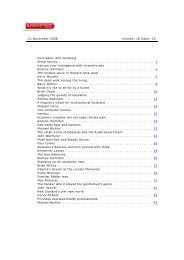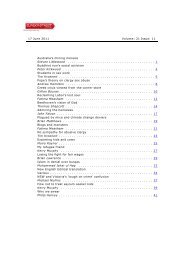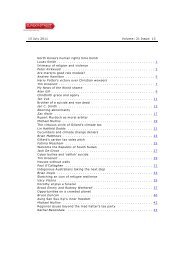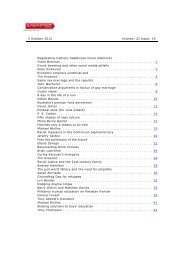25 January 2008 - 1 February 2008 Volume: 18 Issue: 2 Cricket ...
25 January 2008 - 1 February 2008 Volume: 18 Issue: 2 Cricket ...
25 January 2008 - 1 February 2008 Volume: 18 Issue: 2 Cricket ...
You also want an ePaper? Increase the reach of your titles
YUMPU automatically turns print PDFs into web optimized ePapers that Google loves.
<strong>Cricket</strong> viewed from the Tower of Babel<br />
THEOLOGY<br />
Andrew Hamilton<br />
<strong>Volume</strong> <strong>18</strong> <strong>Issue</strong>: 2<br />
<strong>25</strong> <strong>January</strong> <strong>2008</strong> - 1 <strong>February</strong> <strong>2008</strong><br />
Christians, like other people who have sacred books, commonly<br />
look for guidance on questions of everyday life. But it is notoriously<br />
difficult to find illumination about current issues. Take, for<br />
example, the ruckus after the second cricket test between India and<br />
Australia.<br />
That is partly because we instinctively look first for direct and unequivocal<br />
statements. Thou shalt not steal, for example. Such statements let us know who is to<br />
blame for what. But it is usually hard to apply these statements helpfully to modern<br />
events like test matches.<br />
Perhaps, though, deeper illumination is to be found in stories than in instructions,<br />
condemnations and exhortations. Stories do not offer instant judgments but different<br />
and provoking ways of looking at situations.<br />
If you want to reflect on the conflict between the Indian and Australian teams, for<br />
example, you could do worse than detour past the Tower of Babel. It is one of a cycle<br />
of stories that tell how God’s love always intervenes to rescue humanity from the<br />
destructive consequences of its bloody-mindedness.<br />
The Tower of Babel is an image of the capacity of technology to disturb deep<br />
human values. In the story the discovery of bricks and mortar has made possible the<br />
construction of towers and the shaping of cities. New technology and a shared<br />
language inspire a concerted effort to build a tower that will reach to heaven — God’s<br />
world. God responds to this vaulting ambition by confusing the people’s languages.<br />
At first sight, this story seems to say that a controlling God punishes human beings<br />
for their cheeky pride in technology and human progress. But in context it is more<br />
subtle. Although these early stories in the Book of Genesis represent God as<br />
intervening from outside, their deeper concern is to show the inner dynamics of<br />
human action. God is about relationships, and the stories return human beings to<br />
relationships.<br />
The point of this story is that new technology focuses human beings narrowly on<br />
domination and on power. They see human fulfilment in these terms. The new<br />
technologies and the consequent change in economic relationships inspire great<br />
©<strong>2008</strong> EurekaStreet.com.au 1

















